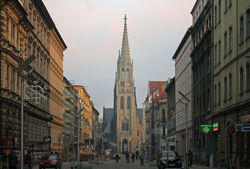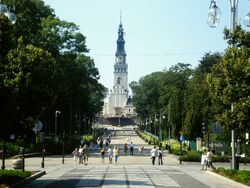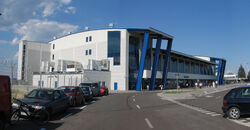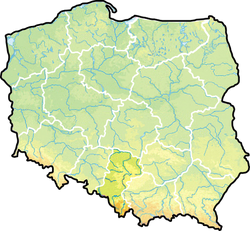| Silesian Voivodeship Województwo śląskie |
|||
|---|---|---|---|
| — Voivodeship — | |||
|
|||
| Location within Poland | |||
| Division into counties | |||
| Coordinates (Katowice): | |||
| Country | |||
| Capital | Katowice | ||
| Counties | 19 cities, 17 land counties *
Bielsko-Biała
Bytom Chorzów Częstochowa Dąbrowa Górnicza Gliwice Jastrzębie-Zdrój Jaworzno Katowice Mysłowice Piekary Śląskie Ruda Śląska Rybnik Siemianowice Śląskie Sosnowiec Świętochłowice Tychy Zabrze Żory Będzin County Bielsko County Bieruń-Lędziny County Cieszyn County Częstochowa County Gliwice County Kłobuck County Lubliniec County Mikołów County Myszków County Pszczyna County Racibórz County Rybnik County Tarnowskie Góry County Wodzisław County Zawiercie County Żywiec County |
||
| Area | |||
| • Total | 12,334 km2 (4,762 sq mi) | ||
| Population (2006) | |||
| • Total | 4,676,983 | ||
| • Density | 380/km2 (980/sq mi) | ||
| • Urban | 3,675,602 | ||
| • Rural | 1,001,381 | ||
| Car plates | S | ||
| Website | http://www.silesia-region.pl | ||
| * further divided into 167 gminas | |||
Silesian Voivodeship, or Silesia Province[1] (in Polish, województwo śląskie [vɔjɛˈvut͡stfɔ ˈɕlɔ̃skʲɛ]), is a voivodeship, or province, in southern Poland, centering on the historic region known as Upper Silesia (Górny Śląsk). Its capital is Katowice.
It was created on January 1, 1999, out of the former Katowice, Częstochowa and Bielsko-Biała Voivodeships, pursuant to the Polish local government reforms adopted in 1998.
History[]
The Silesian voivodeship is historically territorially aligned with the European region of Upper Silesia
History of Upper Silesia[]
At the time of Svatopluk I and King Arnulf of Carinthia in the 9th century, Silesia was a part of Greater Moravia; after its destruction in the early 10th century, it was conquered by Bohemia. A number of earlier inhabitants of Silesia, the Silingi, remained in the region and they concentrated around the Zobten mountain and in a settlement named Niempsch (derived from a Slavic name for Germans).
Upper Silesia was soon conquered by the newly installed dukes of the Polans and for several hundred years was part of Poland. This arrangement fell apart and, during the re-establishment of Poland under Casimir the Great, all of Silesia was specifically excluded as non-Polish land. In 1335 it came back under the rule of the Kingdom of Bohemia. Many towns were destroyed by the Mongols at the Battle of Legnica but were later rebuilt. By the 14th century, the influx of settlers into Upper Silesia stopped because of the plague. Latin, Czech and German language were used in the towns and cities and only in the 1550s (during the Protestant Reformation) did records with Polish names start to appear. The Roman Catholic Holy Roman Emperors of the Habsburg dynasty forcibly reintroduced Catholicism, led by the Jesuits.
Lower Silesia and most of Upper Silesia became part of the Kingdom of Prussia in 1742 during the First Silesian War. A small part remained within the Habsburg-ruled Bohemian Crown as the Duchy of Upper and Lower Silesia, colloquially called Austrian Silesia.
In the 19th century, Upper Silesia became an industrial area taking advantage of its plentiful coal and iron ore.
In 1919, after World War I, the eastern part (with a majority of ethnic Poles) came under Polish rule as the Silesian Voivodeship, while the mostly German-speaking western part remained part of the German Reich as the Province of Upper Silesia. From 1919-1921 three Silesian Uprisings occurred among the Polish-speaking populace of Upper Silesia; the Battle of Annaberg was fought in the region in 1921. In the Upper Silesia plebiscite, a majority of 60% voted against merging with Poland, with clear lines dividing Polish and German communities. The exact border, the maintenance of cross-border railway traffic and other necessary co-operations, as well as equal rights for all inhabitants in both parts of Upper Silesia, were all fixed by the German-Polish Accord on East Silesia,[2] signed in Geneva on May 15, 1922. On June 20, Germany ceded, de facto, the eastern parts of Upper Silesia, becoming part of the Silesian Voivodeship of Poland.
After 1945, almost all of Upper Silesia that was not ceded to Poland in 1922 was transferred to this state. A majority of the German-speaking population was expelled in accordance with the decision of the victorious Allied powers at their 1945 meeting at Potsdam. This expulsion program also included German speaking inhabitants of Lower Silesia, eastern Pomerania, Gdańsk (Danzig), and East Prussia. These German expellees were transported to the present day Germany (including the former East Germany), and they were replaced with Poles, many from former Polish provinces taken over by the USSR in the east. A good many German-speaking Upper Silesians were relocated in Bavaria. A small part of Upper Silesia stayed as part of Czechoslovakia as Czech Silesia.
The expulsions of German-speakers did not totally eliminate the presence of a population that considered itself German. Upper Silesia, in 1945, had a considerable number of Roman Catholic mixed bilingual inhabitants that spoke both German and Polish dialects, and their Polish linguistic skills were solid enough for them to be allowed to remain in the area. With the fall of communism and Poland joining the European Union, there were enough of these remaining in Upper Silesia to allow for the recognition of the German minority in Poland by the Polish government.
Geography[]
Silesian Voivodeship borders both the Czech Republic and Slovakia to the south. It is also bordered by four other Polish voivodeships: those of Opole (to the west), Łódź (to the north), Świętokrzyskie (to the north-east), and Lesser Poland (to the east).
The region includes the Silesian Upland (Wyżyna Śląska) in the centre and north-west, and the Krakowsko-Częstochowska Upland (Jura Krakowsko-Częstochowska) in the north-east. The southern border is formed by the Beskidy Mountains (Beskid Śląski and Beskid Żywiecki).
The current administrative unit of Silesian Voivodeship is just a fraction of the historical Silesia which is within the borders of today's Poland (there are also fragments of Silesia in the Czech Republic and Germany). Other parts of today's Polish Silesia are administered as the Opole and the Lower Silesian Voivodeships. On the other hand, a large part of the current administrative unit of the Silesian Voivodeship is not part of historical Silesia (e.g., Częstochowa, Zawiercie, Myszków, Jaworzno, Sosnowiec, Żywiec, Dąbrowa Górnicza, Będzin and east part of Bielsko-Biała, which are historically Lesser Poland).
Demography[]
Silesian Voivodeship has the highest population density in the country (379 people per square kilometre, compared to the national average of 124). The region's considerable industrialisation gives it the lowest unemployment rate nationally (6.2%). The Silesian region is the most industrialized and the most urbanized region in Poland: 78% of its population live in towns and cities.
Tourism[]
Both northern and southern Silesia is surrounded by a green belt. Bielsko-Biała is enveloped by the magnificent Beskidy Mountains which are particularly popular with winter sports fans. This genuine skier's paradise offers over 150 ski lifts and 200 kilometres of ski routes. More and more slopes are illuminated and equipped with artificial snow generators. Szczyrk, Brenna, Wisła and Ustroń are the most popular winter mountain resorts. Rock climbing sites can be found in admirable corners of Jura Krakowsko-Częstochowska. The ruins of castles forming the Eagle Nests Trail are a famous attraction of the region. While in Silesia, one cannot miss the Black Madonna's Jasna Góra Sanctuary in Częstochowa - the annual destination of over 4 million pilgrims from all over the world.
With its more than two centuries of industrialisation history, region has a number of technical heritage memorials. These include narrow and standard gauge railways, coal and silver mines, shafts and its equipment from 19th and 20th century.
Cities and towns[]

Katowice is the capital of the Silesian Voivodeship

Jasna Góra in Częstochowa is the holiest catholic shrine in Poland
Due to its industrial and urban nature, the voivodeship has many cities and large towns. Of Poland's 40 most-populous cities, 12 are in Silesian Voivodeship. 19 of the cities in the voivodeship have the legal status of city-county (see powiat). In all it has 71 cities and towns (with legal city rights), listed below in descending order of population (according to official figures for 2006[3]):
|
|
|
Economy[]
The Silesian voivodship is predominantly an industrial region. Most of the mining is derived from one of the world's largest bituminous coalfields of the Upper Silesian Industrial District (Górnośląski Okręg Przemysłowy) and the Rybnik Coal District (Rybnicki Okręg Węglowy) with its major cities Rybnik, Jastrzębie Zdrój, Żory and Wodzisław Śląski. Lead and zinc can be found near Bytom, Zawiercie and Tarnowskie Góry; iron ore and raw materials for building - near Częstochowa. The most important regional industries are: mining, iron, lead and zinc metallurgy, power industry, engineering, automobile, chemical, building materials and textile. In the past, the Silesian economy was determined by coal mining. Now, considering the investment volume, car manufacturing is becoming more and more important. The most profitable company in the region is Fiat Auto-Poland S.A. in Bielsko-Biała with a revenue of PLN 6.2 billion in 1997. Recently a new car factory has been opened by GM Opel in Gliwice. There are two Special Economic Zones in the area: Katowice and Częstochowa. The voivodship's economy consists of about 323,000, mostly small and medium-sized, enterprises employing over 3 million people. The biggest Polish steel-works "Huta Katowice" is situated in Dąbrowa Górnicza.
Silesian Voivodship is also one of the richiest regions in Poland. Average salary is about 3 800 zlotychs (over 1 200 EUR).
Transport[]

Terminal 2 of Katowice International Airport in Pyrzowice
Katowice International Airport (in Tarnowskie Góry County) is used for domestic and international flights, Other Nearby Airports are John Paul II International Airport Kraków-Balice and Warsaw Frédéric Chopin Airport. The Silesian agglomeration railway network has the largest concentration in the country. The voivodship capital enjoys good railway and road connections with Kraków (motorway A4), Wrocław (motorway A4), Łódź and Warsaw. It is also the crossing point for many international routes like E40 connecting Calais, Brussels, Cologne, Dresden, Wrocław, Kraków and Kiev and E75 from Scandinavia to the Balkans. A relatively short distance to Vienna facilitates cross-border co-operation and may positively influence the process of European integration. Linia Hutnicza Szerokotorowa (known by its acronym LHS, English: Broad gauge metallurgy line) in Sławków is the longest broad gauge railway line in Poland. The line runs on a single track for almost 400 km from the Polish-Ukrainian border, crossing it just east of Hrubieszów. It is the westernmost broad gauge railway line in Europe that is connected to the broad gauge rail system of the countries of the former Soviet Union.
Education[]
There are eleven public universities in the voivodship. The biggest university is the University of Silesia in Katowice, with 43,000 students. The region's capital boasts the Medical University, The Karol Adamiecki University of Economics in Katowice, the University of Music in Katowice, the Physical Education Academy and the Academy of Fine Arts. Częstochowa is the seat of the Częstochowa University of Technology and Pedagogic University. The Silesian University of Technology in Gliwice is nationally renowned. Bielsko-Biała is home of the Technical-Humanistic Academy. In addition, 17 new private schools have been established in the region.
There are more than 300,000 people studying in the voivodship.
Politics[]
The Silesian voivodeship's government is headed by the province's voivode (governor) who is appointed by the Polish Prime Minister. The voivode is then assisted in performing his duties by the voivodeship's marshal, who is the appointed speaker for the voivodeship's executive and is elected by the sejmik (provincial assembly). The current voivode of Silesia is Zygmunt Łukaszczyk, whilst the present marshal is Bogusław Śmigielski.
The Sejmik of Silesia consists of 48 members.
| Silesian Regional Assembly elections on 21 November 2010[4] | |||
|---|---|---|---|
| Party | Votes | Percent | Seats |
| Civic Platform (PO) | ? | 33,7% | 22 |
| Law and Justice (PiS) | ? | 20,8% | 11 |
| Left and Democrats (SLD) | ? | 16,4% | 10 |
| Silesian Autonomy Movement (RAS) | 122,781 | 8.49% | 3 |
| Polish People's Party (PSL) | ? | 7,10% | 2 |
Administrative division[]
Silesian Voivodeship is divided into 36 counties (powiats). These include 19 city counties (far more than any other voivodeship) and 17 land counties. The counties are further divided into 167 gminas.
The counties are listed in the following table (ordering within categories is by decreasing population).
| English and Polish names |
Area (km²) |
Population (2006) |
Seat | Other towns | Total gminas |
| City counties | |||||
| Katowice | 165 | 315,996 | 1 | ||
| Częstochowa | 160 | 246,129 | 1 | ||
| Sosnowiec | 91 | 225,202 | 1 | ||
| Gliwice | 134 | 199,099 | 1 | ||
| Zabrze | 80 | 190,610 | 1 | ||
| Bytom | 69 | 187,205 | 1 | ||
| Bielsko-Biała | 125 | 176,678 | 1 | ||
| Ruda Śląska | 78 | 145,929 | 1 | ||
| Rybnik | 148 | 141,382 | 1 | ||
| Tychy | 82 | 130,842 | 1 | ||
| Dąbrowa Górnicza | 188 | 129,753 | 1 | ||
| Chorzów | 33 | 114,434 | 1 | ||
| Jaworzno | 152 | 96,051 | 1 | ||
| Jastrzębie-Zdrój | 85 | 95,149 | 1 | ||
| Mysłowice | 66 | 74,988 | 1 | ||
| Siemianowice Śląskie | 25 | 72,451 | 1 | ||
| Żory | 65 | 62,625 | 1 | ||
| Piekary Śląskie | 40 | 59,494 | 1 | ||
| Świętochłowice | 13 | 55,172 | 1 | ||
| Land counties | |||||
| Cieszyn County powiat cieszyński |
730 | 171,029 | Cieszyn | Ustroń, Skoczów, Wisła, Strumień | 12 |
| Wodzisław County powiat wodzisławski |
287 | 155,228 | Wodzisław Śląski | Rydułtowy, Radlin, Pszów | 9 |
| Będzin County powiat będziński |
368 | 151,122 | Będzin | Czeladź, Wojkowice, Sławków, Siewierz | 8 |
| Bielsko County powiat bielski |
457 | 150,764 | Bielsko-Biała * | Czechowice-Dziedzice, Szczyrk, Wilamowice | 10 |
| Żywiec County powiat żywiecki |
1,040 | 149,492 | Żywiec | 15 | |
| Tarnowskie Góry County powiat tarnogórski |
643 | 137,979 | Tarnowskie Góry | Radzionków, Kalety, Miasteczko Śląskie | 9 |
| Częstochowa County powiat częstochowski |
1,519 | 133,553 | Częstochowa * | Blachownia, Koniecpol | 16 |
| Zawiercie County powiat zawierciański |
1,003 | 124,127 | Zawiercie | Poręba, Łazy, Ogrodzieniec, Szczekociny, Pilica | 10 |
| Gliwice County powiat gliwicki |
663 | 114,963 | Gliwice * | Knurów, Pyskowice, Toszek, Sośnicowice | 8 |
| Racibórz County powiat raciborski |
544 | 111,505 | Racibórz | Kuźnia Raciborska, Krzanowice | 8 |
| Pszczyna County powiat pszczyński |
473 | 104,638 | Pszczyna | 6 | |
| Mikołów County powiat mikołowski |
232 | 91,022 | Mikołów | Łaziska Górne, Orzesze | 5 |
| Kłobuck County powiat kłobucki |
889 | 84,730 | Kłobuck | Krzepice | 9 |
| Lubliniec County powiat lubliniecki |
822 | 76,628 | Lubliniec | Woźniki | 8 |
| Rybnik County powiat rybnicki |
225 | 73,527 | Rybnik * | Czerwionka-Leszczyny | 5 |
| Myszków County powiat myszkowski |
479 | 71,619 | Myszków | Żarki, Koziegłowy | 5 |
| Bieruń-Lędziny County powiat bieruńsko-lędziński |
157 | 55,868 | Bieruń | Lędziny, Imielin | 5 |
| * seat not part of the county | |||||
Protected areas[]
Protected areas in Silesian Voivodeship include eight areas designated as Landscape Parks:
- Eagle Nests Landscape Park (partly in Lesser Poland Voivodeship)
- Little Beskids Landscape Park (partly in Lesser Poland Voivodeship)
- Rudy Landscape Park
- Silesian Beskids Landscape Park
- Stawki Landscape Park
- Upper Liswarta Forests Landscape Park
- Załęcze Landscape Park (partly in Łódź Voivodeship)
- Żywiec Landscape Park
Most popular surnames in the region[]
- Nowak: 31,838
- Kowalski: 11,811
- Wójcik: 11,440
See also[]
- History of Silesia
- Silesian Uprisings
References[]
- ^ Arkadiusz Belczyk,Tłumaczenie polskich nazw geograficznych na język angielski [Translation of Polish Geographical Names into English], 2002-2006.
- ^ Cf. Deutsch-polnisches Abkommen über Ostschlesien (Genfer Abkommen)
- ^ http://www.stat.gov.pl/gus/45_655_PLK_HTML.htm
- ^ "Silesian Regional Assembly elections". State Electoral Commission. http://wybory2010.pkw.gov.pl/geo/pl/240000/240000.html. Retrieved 2011.
External links[]
- The Website of Silesia
- Województwo Śląskie Official website
Template:Silesian Voivodeship
Template:Silesia topics
| This page uses content from the English language Wikipedia. The original content was at Silesian Voivodeship. The list of authors can be seen in the page history. As with this Familypedia wiki, the content of Wikipedia is available under the Creative Commons License. |




